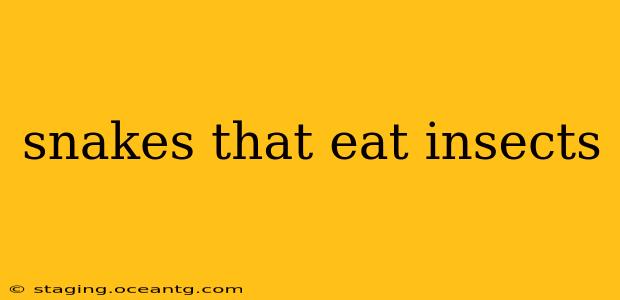Snakes, often associated with fear and danger, exhibit incredible diversity in their diets. While many are known for consuming rodents, birds, or even other snakes, a significant number of species are dedicated insectivores, meaning insects form the cornerstone of their diet. Understanding these fascinating creatures requires exploring their unique adaptations, habitats, and the crucial role they play in ecosystems. This guide delves into the world of snakes that eat insects, answering many common questions along the way.
What kinds of insects do snakes eat?
The insect menu for insectivorous snakes is surprisingly varied. They commonly consume crickets, grasshoppers, beetles, caterpillars, ants, termites, and even spiders (which are arachnids, not insects). The specific insect prey depends largely on the snake's size, location, and the availability of food sources. Smaller snakes naturally target smaller insects, while larger species might tackle larger prey items like locusts or larger beetles. Their diet often reflects the abundance of insect life in their particular habitat.
What are some examples of snakes that eat insects?
Numerous snake species are primarily insectivores. Some notable examples include:
-
Blind Snakes (Family Typhlopidae): These small, burrowing snakes are almost exclusively insectivores, feeding on ants, termites, and other subterranean insects. Their specialized skulls and slender bodies are perfectly adapted for navigating burrows and capturing their prey.
-
Thread Snakes (Family Leptotyphlopidae): Similar to blind snakes, thread snakes are small and burrow extensively, specializing in consuming ants and termites.
-
Some species of Worm Snakes (Family Leptotyphlopidae): While many worm snakes have broader diets, several species rely heavily on insects, particularly ants and termites, for sustenance.
-
Many species of small colubrid snakes: Various small colubrid snakes found across different regions incorporate insects into their diet, often alongside other small invertebrates. Their diets can be quite variable depending on their environment.
How do snakes that eat insects hunt?
Insectivorous snakes employ different hunting strategies depending on their prey and environment. Some, like blind snakes, rely on ambush techniques, patiently waiting in insect burrows or tunnels to seize unsuspecting prey. Others might actively forage, searching for insects on the surface or within leaf litter. Many utilize their highly sensitive chemoreceptors (Jacobson's organ) to detect the scent of their insect prey. Their quick strikes and efficient swallowing mechanisms ensure effective capture and consumption.
Where do snakes that eat insects live?
Insectivorous snakes inhabit a wide range of habitats across the globe. Their distribution is influenced by the availability of insect prey. You'll find them in various environments, including:
-
Tropical and subtropical forests: These areas support a high diversity of insects, providing abundant food for insectivorous snakes.
-
Grasslands and savannas: These open habitats often harbor large populations of grasshoppers, beetles, and other insects.
-
Deserts: Some specialized species have adapted to survive in arid environments, where they feed on desert-dwelling insects.
-
Subterranean environments: Blind snakes and thread snakes are masters of the underground world, exploiting the rich insect life beneath the surface.
Are snakes that eat insects dangerous to humans?
The vast majority of snakes that specialize in eating insects pose no threat to humans. Their small size and non-venomous nature make them largely harmless. However, as with any wild animal, it's advisable to observe them from a safe distance and avoid handling them unnecessarily.
What is the role of insectivorous snakes in the ecosystem?
Insectivorous snakes play a vital role in regulating insect populations. By controlling the numbers of insects, they help maintain ecological balance within their habitats. This can be particularly significant in agricultural settings, where controlling insect pests is crucial for crop production.
This comprehensive overview provides a deeper understanding of the fascinating world of snakes that eat insects. Their unique adaptations, diverse habitats, and important ecological roles highlight the rich biodiversity within the snake family. Remember always to respect wildlife and maintain a safe distance when observing these intriguing creatures in their natural environment.
